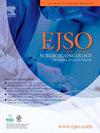A novel risk score after neoadjuvant imatinib predicts relapse-free survival in patients with gastrointestinal stromal tumours (GIST)
IF 2.9
2区 医学
Q2 ONCOLOGY
引用次数: 0
Abstract
Introduction
Surgery remains the cornerstone of management of localized GIST. Neoadjuvant imatinib facilitates surgery and allows in vivo monitoring of tumour response to therapy. There are no predictive tools to guide the duration of treatment. This study evaluates the impact of clinical and pathological variables on relapse-free survival (RFS) after neoadjuvant imatinib.
Material and methods
Single-centre retrospective study of 90 GIST patients who underwent radical surgery after neoadjuvant imatinib. Univariate and multivariate Cox regression analyses were performed to determine the association of clinicopathological variables to RFS. Evaluate Cut-points were used to identify values associated with significantly different outcomes. Between-group differences were assessed with the use of the stratified log-rank test.
Results
Univariate Cox regression analyses showed a significant association of RFS with initial tumour size (ITS) (HR 1.11, p = 0.002), maximal tumour shrinkage (MTS) (HR 11.7, p = 0.023) and residual mitotic count (RMC) (HR 1.09, p ≪ 0.001). These results were confirmed in a multivariate model (ITS, p = 0.001; MTS, p = 0.003; RMC, p ≪ 0.001). Cut-points for ITS, MTS and RMC were established at 9.8 cm, 41 % reduction in size and 2 mitoses, respectively. Patients with large tumours ≥9.8 cm, ≤41 % reduction in size and ≥2 mitoses had shorter RFS. A combined score of these three variables allowed for accurate classification into two risk categories (p ≪< 0.001): low (0 or 1 factor) and high-risk (2 or 3 factors). Post-operative imatinib did not influence survival outcomes in either low -risk (HR 1.2, p = 0.83) or high-risk patients (HR 1.6, p = 0.35).
Discussion
ITS, MTS and RMC are associated with shorter RFS in patients with localized GIST treated with neoadjuvant imatinib. If validated, these findings could guide the design of prospective studies that de-escalate or intensify adjuvant treatment.
新辅助伊马替尼后的一种新的风险评分预测胃肠道间质瘤(GIST)患者的无复发生存
手术仍然是治疗局部GIST的基石。新辅助伊马替尼促进手术,并允许体内监测肿瘤对治疗的反应。目前还没有预测工具来指导治疗的持续时间。本研究评估临床和病理变量对新辅助伊马替尼治疗后无复发生存(RFS)的影响。材料与方法对90例接受新辅助伊马替尼根治性手术的GIST患者进行单中心回顾性研究。进行单因素和多因素Cox回归分析以确定临床病理变量与RFS的关系。评估切割点用于识别与显著不同结果相关的值。采用分层对数秩检验评估组间差异。结果单因素Cox回归分析显示,RFS与初始肿瘤大小(ITS)(危险度1.11,p = 0.002)、最大肿瘤缩小(MTS)(危险度11.7,p = 0.023)和剩余有丝分裂计数(RMC)(危险度1.09,p≪0.001)有显著关联。这些结果在多变量模型中得到证实(ITS, p = 0.001; MTS, p = 0.003; RMC, p≪0.001)。ITS, MTS和RMC的切割点分别为9.8 cm,大小减少41%和2个有丝分裂。大肿瘤≥9.8 cm、缩小≤41%、有丝分裂≥2次的患者RFS较短。这三个变量的综合得分可以准确地分为两类风险(p≪< 0.001):低风险(0或1个因素)和高风险(2或3个因素)。术后伊马替尼对低危患者(HR 1.2, p = 0.83)或高危患者(HR 1.6, p = 0.35)的生存结果均无影响。在接受新辅助伊马替尼治疗的局部GIST患者中,its、MTS和RMC与较短的RFS相关。如果得到证实,这些发现可以指导前瞻性研究的设计,降低或加强辅助治疗。
本文章由计算机程序翻译,如有差异,请以英文原文为准。
求助全文
约1分钟内获得全文
求助全文
来源期刊

Ejso
医学-外科
CiteScore
6.40
自引率
2.60%
发文量
1148
审稿时长
41 days
期刊介绍:
JSO - European Journal of Surgical Oncology ("the Journal of Cancer Surgery") is the Official Journal of the European Society of Surgical Oncology and BASO ~ the Association for Cancer Surgery.
The EJSO aims to advance surgical oncology research and practice through the publication of original research articles, review articles, editorials, debates and correspondence.
 求助内容:
求助内容: 应助结果提醒方式:
应助结果提醒方式:


